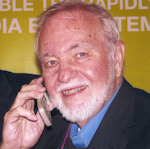It was inevitable. Someone was going to put most of the circuitry for a cell phone onto one chip. Giants like Texas Instruments and Infineon have come close to doing it. But Silicon Laboratories grabbed the ring, integrating the most cell-phone circuitry on one chip.
But does a smaller and less expensive phone counter the direction of most cell-phone designs? Yes, because today's trend slants toward more sophisticated feature phones or smart phones that include the cameras, audio, games, and even video.
Nonetheless, a huge and growing market exists for entry-level-and ultra-low-cost phones. This chip fits well in that burgeoning arena, and Silicon Laboratories should capture a major share of that market.
What makes the AeroFONE remarkable is its combination of a sensitive RF receiver on the same chip as a bunch of noisy highspeed digital circuits. Such noise seriously degrades receiver sensitivity, and that's just what's needed to minimize dropped calls by maintaining a solid link to a cell site when using the phone indoors or an extra long distance from the site.
The usual procedure places the RF circuits as far from the digital circuits as possible, even if it's on opposite ends of the pc board. If that doesn't work, shielding is added. But Silicon Labs cleverly isolated the RF and digital circuits on the same chip. It also looked for a chip architecture that would allow colocation, in addition to acceptable clock frequencies.
This results in not only the most fully integrated cell-phone chip, but one that provides a ?113-dBm receiver sensitivity on all bands. Silicon Labs' advanced mixed-signal design expertise and its success with its Aero II transceiver chips made it possible.
The Si4905 is a GSM/GPRS cell phone covering the four popular bands here and in Europe. Its on-chip digitally controlled crystal oscillator (DCXO) eliminates the need for an external voltage-controlled temperature-compensated crystal oscillator (VC-TCXO). The digital baseband supports GPRS classes 1 through 12 as well as class B and C and coding schemes CS1-CS-4.
The digital audio subsystem includes a microphone amplifier, three differential audio output amplifiers, an alternate 40-ksample/s audio mode for polyphonic ringtones, speaker phone with noise suppression and echo cancellation, and HR/FR/EFR/AMR vocoders.
An ARM9E core and a Ceva Teak DSP handle the processing chores. All of the necessary 2-Mbit SRAM resides on-chip, but the interface for external flash is provided. The power-management unit includes the battery charger as well as multiple LDOs and dc-dc converters.
Another key feature is AeroFONE's unique global software architecture. The ultra-flexible Silicon Labs software platform makes the phone compatible with multiple software protocol stacks, operating systems, and applications frameworks.
This approach lowers software switching costs by enabling handset developers to reuse existing software, or to select one of the multiple protocol stacks and application software frameworks validated by Silicon Labs and its partners TTPCom, CCww, and Stackcom. TTPCom contributed a proven digital modem IP and protocol stack. The AeroFONE software suite's smart platform and system driver libraries greatly reduce software development costs while improving time-to-market performance and quality.
The impact on single-chip cell-phone manufacturing is dramatic.-The number of pc-board insertions is reduced by over 200. In addition, component count is decreased by 75%, board area by 65%, and total manufacturing cost by 50% (see the figure). Calibration and test time also are greatly reduced. The outcome is higher manufacturing yields and greater product reliability.
The Si4905 comes in a lead-free, 12- by 12-mm plastic ballgrid-array (PBGA) package that complies with the RoHS regulations. Samples are available now with full production scheduled for the second quarter of 2006. Price depends on volume. An evaluation board with accompanying materials is available now for $5000.
